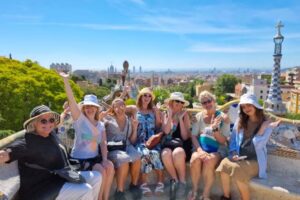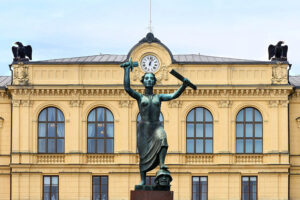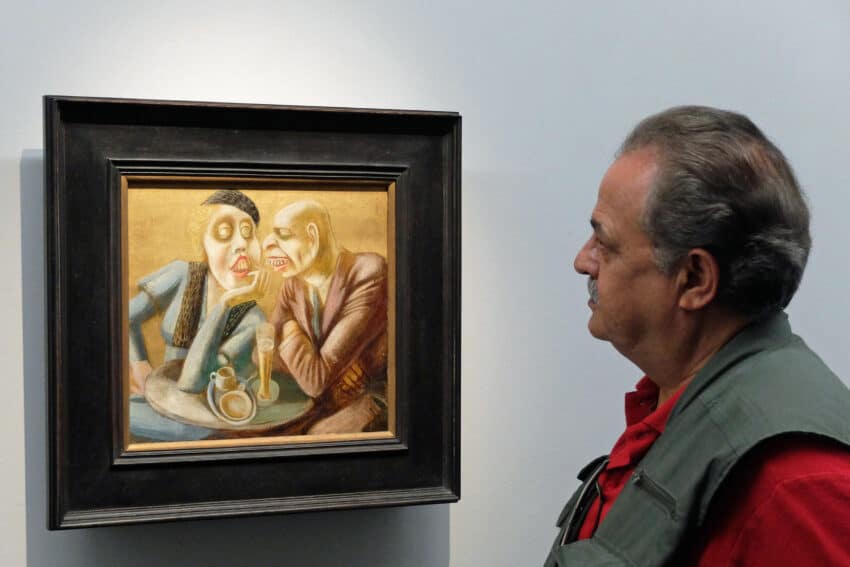
By Dianne Thomas
Maputo, the capital city of Mozambique, is a welcoming city of contrasts with a lively, yet laid back appeal; its old-style Portuguese buildings sit alongside faded retro buildings or tucked away next to modern skyscrapers.
The long, wide avenues entice you to take leisurely strolls to the background of Mozambican beats that play out from street corners where locals hang out and vendors peddle their wares.

Portugsese Colonial History
Mozambique’s history has been colored by centuries of a fusion of Arab, Indian and Portuguese colonialism motivated by the passing trades of slavery and the busy ports on the Indian Ocean. Their cultures and influence still are very much part of the Mozambican way of life.
More recently, during the late ’70s and ’80s, its inhabitants lived through a sixteen-year guerrilla war, leaving a shaky and vulnerable nation in its wake. Fast forward to today this African state has re-ignited its vibrancy and is now one of Africa’s desired destinations.
Getting around Maputo
Having negotiated a chapa (type of crowded van that acts like a bus) we were dropped off in Baixe de Maputo, the old port and bay, where many of the sights are situated. Fortunately, most central attractions are easily accessible by walking but taxis are cheap if you have to go farther, just make sure they have a meter or agree on a price first.
En route, there were plenty of cafe-bars and pastelarias we stopped in to sample the local beer or a cake from under the shaded covers on the streets and relaxed into the rhythm of the passing scenes.
A choice of markets
Housed in a beautiful 100-year-old shabby building is the Muncipal Market – a definite place to shop. It is crammed with stalls laid out in sections selling everything: woven baskets and bags in all designs and sizes; tables lined with bowls of chilies and mounds of fresh tropical fruit and vegetables; neat rows of cashews nuts or spices are piled high; souvenirs and even, to our amusement, a wig section.

The market is very busy and common advice is that it’s best to be wary against pickpockets. It is also a good idea to ask for photos as some people can take offense.
Wandering around opposite the market entrance we found small shops which sell excellent cupalanas (sarongs) with unusual designs and reasonably priced but be prepared to jostle with the other women for service.
Nearby, is Cafe Continental, a favorite amongst Maputo’s cafe culture and a must to stop and order a delicious pastry. However, it is the 1930s shabby chic decor and the feel of the place that attracted us to stay and order another milky chocolate.
If possible, the Saturday Craft Market should be worked into your agenda – we frittered away hours in search of treasured souvenirs.
Brightly colored batiks lured us into the long stretches of stalls selling distinctive carvings made from ebony and sandalwood, canvas paintings, wooden toys and tribal jewelry which are abundant in choice. Recycling here goes a long way and there are many riches to be made from tin cans or plastic bags.

Most traders are artisans so although they will haggle a fee, it is best not to insult them as you won’t get very far. Generally though, as most Mozambicans do, they are happy for you to stop for a chat and friendly banter to agree on a price, and we left with bags full of exquisite mementos.
For a distraction from the market, we escaped to the peaceful, well-kept garden of the Fortaleza with its war statues and rusty weaponry. Built by the Portuguese, it’s the place if you want to brush up on some military and currency history. The top wall, alongside the cannons, is also ideal for a photo opportunity of the animated market below and the taller buildings that surround it.
‘Guns into Art’
For searching out art with a difference we headed to the Nucleo de Arte, an essential meeting point of cultural activity for Mozambican artists, and have been for over a number of decades. It is located in an old villa in Baixe de Maputo and regularly hosts exhibitions from its members or artists from abroad.
Here, a variety of artists work with different mediums but much of the permanent collection, ‘Guns into Art,’ are sculptures made from AK-47 machine guns, landmines and grenades left over and collected from the civil war.

Often, the artists themselves are busy working in the makeshift studios and Cafe Camissa, on the adjoining terrace, provides the opportunity to chat, meet local artists and tuck into a cheap snack. Unfortunately, there were no events on when we visited but the weekends are more likely to have live music.
The Hidden Gems
Usually, a visit to a train station includes traveling on a train but in the case of Maputo’s railway station, we visited it because of its renowned splendor.

It was originally designed by the Eiffel tower famed architect, Gustav Eiffel in 1910 but has been renovated in recent times (its revolving doors were added for the film, Blood Diamond, starring Leonardo Di Caprio). As you enter the huge central dome overwhelms you with its design and size.
As we wandered round the virtually empty stations, its grand platforms with overhangs arching, marble pillars, and ornate detail oozed romanticism. On the tracks, old steam engines stand proudly, reminiscent of their time, have been carefully preserved.
Just outside the station in Praça dos Trabalhadores amongst the taxis, crowded bus bays and against the backdrop of a 1960’s block of flats baring a huge Manica sign, is a statue which pays homage to the soldiers of the Great War.
Sculpted by Portuguese artist, Rui Gameiro, it depicts a woman killing a cobra in a pot of boiling water and she stands warrior-like in the middle of the traffic whilst locals have a siesta under her shade.
>
Taking a breathing space from urban concrete, Jardim Tunduro, the botanical gardens offers tranquillity for the weary tourist. Entering the gates, we passed the bronze statue of Samora Machel, the first president of the People’s Republic of Mozambique.
This shaded, tropical greenery, was dotted with young and old folk meeting up, families have picnics and workers stopping off for a break. Nearby is a tennis club where you can catch yourself a local dish as well as watching, or even playing, (by arrangement), a game.
Also close by at the crossroads of Samora Machel and 25 de Setembro is City Hall and the Cathedral of Our Lady of Conception, the latter is an impressively tall white building in the modern design of a cross.
Eating out in the fish market
Mercado de Peixe, further out on the northern coast, is no ordinary place to buy your fish: its secret is the combined open air restaurants that lie adjacent to the fish market where scurrying waiters cook the fish that we buy, on outdoor coal fires.
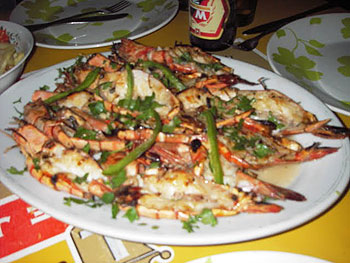
After weaving through the mingling lines of a range of shell and sea fish, we choose a stall and order kilos of her delicious looking prawns. We then take them to another table to be weighed.
Just as we are told a price, our waitress runs over and bursts the bag with her knife and immediately water comes gushing out and we realize that had it not been for our kindly waitress, we would have been eating a lot less prawns.
Unhappily, our prawn seller refills our bag to its correct weight but it is all done with good humor and a Mozambican smile. It was a lesson learned!
We sampled wines from South Africa until a feast of luscious prawns, grilled over coals, and the size of my hand arrives. The aromas of a classic Mozambican dish: succulent prawns with the tails left on cooked with lemon, garlic, and parsley, (the latter also purchased at the market). Another dish has the added peri peri, chili peppers grilled opened flat.
To end the day, we take a stroll on the beach and order a capirihana in one of the beach bars to watch the sunset over the Indian Ocean.
Getting there:
South African Airlines operates twice a day while the Mozambican airline organizes inland flights.
Tourist information:
For details of accommodation and other attractions in Maputo and Mozambique try Time Out, mozambiquehappenings and Nucleo de Arte
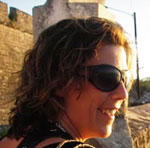
Dianne Thomas lives in London. She works as a teacher and an aspiring writer and travels whenever she can.
- These 9 U.S. National Parks Require Reservations in 2024 - April 17, 2024
- Take a Hike in Olympic National Park - April 17, 2024
- The Wild Mississippi: 2340 Miles Across Ten States - April 8, 2024


